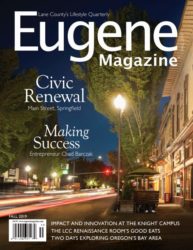Harmonic Laboratory is an arts feast maker—so much so, there’s almost too much to talk about, or listen to, or watch. And to further complicate matters, many of the Lab’s artistic endeavors reach beyond convention and are difficult to describe.
The Lab came into being a decade ago, forged in a collaboration of four creatives, all educators, all faculty members tied to the University of Oregon: Brad Garner, John Park, Jeremy Schropp, and Jon Bellona. Their collective expertise crosses boundaries incorporating dance, choreography, animation, music composition, musical performance, digital imaging, video projection mapping, audio engineering, and indeed, much more.
Over the past decade, the Lab’s leaders have driven more than two dozen innovative public art performances and installations. By Lab description, the exhibits have integrated art with science and humanities “in the development of creative works that tell stories and unpack the dense cultural content around us.” Most projects have fashioned collaborations between multi-disciplinary artists ranging from folk, ballet, and jazz dancers to rock bands to film makers to vocalists to string ensembles to kinetic sculptors to stage actors to electronic musicians and everyone in between.
Meanwhile, handshakes to Schropp for his role as the Lab’s curator of Artistic Encounters, a venture shared with Eugene Cultural Services that brings unique arts experiences to downtown twice a week from May to October. The program showcases widely varied artists (like, for example, mask maker and effects specialist, Todd Bokich) at free outdoor workshops and performances.
What’s on the current Lab menu? A couple notables.
The Winter Lights Video Art Exhibition will illuminate vacant downtown Eugene storefronts with the light, color, and the wonder of animation and video projections for much of the cold season. And in mid-January, the Lab will open an interactive gallery exhibition in the Maurie Jacobs Community Room at the Hult Center. Installations will fold technologies employed by renowned film and video performance collective, Manual Cinema, with innovative multimedia works designed by the Lab. Think shadow puppets, live actors, live music, video, and story-telling.

